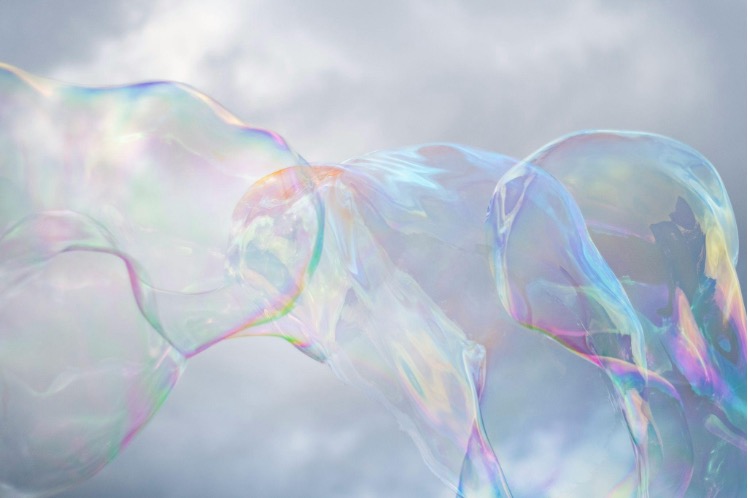What do entrepreneurship and ski touring have in common? Turns out a lot.
What do entrepreneurship and ski touring have in common? Turns out a lot.
Planning and building a new business has a lot in common with a hiking tour in the high mountains: planning, timing, and rhythm - they all determine the success of a company’s journey.

Founding a company has often been compared to building a house or some other structure, a metaphor that creates a mental map for the participants to use on their journey. But I find there is a much more appropriate metaphor: a ski tour in the high mountains. The parallels begin with the brainstorming and planning phase.
Our esteemed b2venture Angel Investor Stefan Loacker had meticulously planned a four-day tour in the high mountains of the Valais, which may sound like a lot, but when hiking 4,000 meters above sea level, it is important to plan everything out: it could be the difference between life and death (this is really so, I will never forget seeing the rocks where a tragedy unfolded four years before us on the same tour - also related to group dynamics you can very often observe in startups - or startup boards, but that is a topic for another blog post).
It takes a lot of detailed planning to be on route for four days at this altitude and a willingness to take risks. This step is exactly the same in a startup: What can our team do and what are realistic goals we can set for our trip? Where are the best views, the upside potential within our own capabilities and how far can and do we want to push our own limits?
It is important to keep the load on the backpack to a minimum so that you can walk long distances with as little worry as possible. This is also true for a startup: It is better to have a small, very strong and resilient team, but to really outgrow yourself and avoid mistakes that have been solved 1,000 times, you have to partner with someone, who has done it several times - a very good and experienced mountain guide. With Hanspeter Dubach, we were extremely lucky. His guidance and protection from danger was very subtle, and he was calm and clear. With startups, it's the same. First-time founders can't know it all. They don't have to, even if they are the ones who are in charge of the company. That is why you have aligned Super Angels as coaches, mentors and later on senior employees that you bring in.

It is equally important for the startup and the ski tour to find a common rhythm when things finally get going. Prof. Heike Bruch has discovered the energy of organizations and described how it can be managed. If you want to "get into the flow" and achieve sustained top performance, that's what it's all about. This is challenging and often requires overcoming inner resistance. The group helps you start early - who wants to be late? But not everyone is fit before dawn. During the first hour you may not be in the flow. This is also the case in companies, and it is a matter of coordination, being considerate, and biting the bullet.
If you get up early for a ski tour, you are usually rewarded with beautiful sunrises, sometimes several, the play of light on the mountains and the sunset long after you have arrived at the next hut. Those who work more and more and longer in the startup phase become more and more unfocused, lose energy, then get up later and later or are tired and the vicious circle is perfect. Getting up early is a matter of discipline. It's something you learn very well in the high mountains.

In the same way, in the high mountains you learn to push your own limits. There are people who are free from the fear of heights. I am not one of them, and five years ago, I could hardly have a look down from a balcony on the second floor of a building. Stefan helped me to overcome this fear literally step by step. Our subconscious protects us with vertigo, but it can also be a hindrance and rob us of great experiences. Entrepreneurs, who don't dare to think bigger, often limit themselves. This is another area where teams can work wonders.
It is good and right to push one's limits. I have seen many entrepreneurs grow even faster than their startups. It always impresses me. But very few on this planet are Steve Jobs or Bill Gates, who are strong in the very early stages, as well as in the growth phase. So when does the moment come when you realize that you are doing the organization a favor by preparing the succession? Again, the mountain is a very good analogy. Some bodies are better equipped for efforts above 3000 meters than others, whose lungs and hearts may have to work much harder. How far can you train and learn in such a situation, and when should you say "up to here and no further"?
You have a limited amount of energy and resources. You have to make the best use of them during a ski tour or a launch. To do this you need the best possible technique. The steeper the angle of ascent (or the greater the challenge), the smaller the number of steps to be taken. The flatter the terrain, the bigger the steps, and in horizontal passages you can even use your own momentum to slide 10 to 30 cm with each step. This adds up to 200m at 1,000 steps per day. And it is precisely these last 200 meters that are known to cost you the most energy.
The most interesting parallels for me are that the journey is the destination. The path is training, pushing boundaries and time for reflection. On the other hand, the hike enriches the entrepreneur in that the distance from the daily business and the inner peace associated with nature help to prioritize or even "cleanse the soul". The higher you go, the broader your horizon and the more you see the bigger picture.

When you reach the top of the mountain, there is a great sense of joy, and you thank and congratulate all of those with whom you have achieved this. Another unexpected parallel: one also needs a lot of energy for descent! You need to reserve at least 40% of your total energy for the trip down. This is a major reason why the accident statistics for ski touring are so high. What do entrepreneurs do when they are at their material zenith? How do they find a new mission once they have reached the proverbial top?
Figuring out what to do with your material wealth through charity, philanthropy and other activities, as well as transferring success to the next generation can also be exhausting and requires hard work. As an intergenerational firm, we at b2venture believe strongly that an important part of the journey for an entrepreneur begins after the original mission of scaling a company to success is over, and that helping a new generation find their way up the mountain is just as important. That’s the promise of our angel investor community and why we work to connect generations so that they can learn from each other - to enrich the ecosystem and help each one of us have more impact together.
Planning and building a new business has a lot in common with a hiking tour in the high mountains: planning, timing, and rhythm - they all determine the success of a company’s journey.

Founding a company has often been compared to building a house or some other structure, a metaphor that creates a mental map for the participants to use on their journey. But I find there is a much more appropriate metaphor: a ski tour in the high mountains. The parallels begin with the brainstorming and planning phase.
Our esteemed b2venture Angel Investor Stefan Loacker had meticulously planned a four-day tour in the high mountains of the Valais, which may sound like a lot, but when hiking 4,000 meters above sea level, it is important to plan everything out: it could be the difference between life and death (this is really so, I will never forget seeing the rocks where a tragedy unfolded four years before us on the same tour - also related to group dynamics you can very often observe in startups - or startup boards, but that is a topic for another blog post).
It takes a lot of detailed planning to be on route for four days at this altitude and a willingness to take risks. This step is exactly the same in a startup: What can our team do and what are realistic goals we can set for our trip? Where are the best views, the upside potential within our own capabilities and how far can and do we want to push our own limits?
It is important to keep the load on the backpack to a minimum so that you can walk long distances with as little worry as possible. This is also true for a startup: It is better to have a small, very strong and resilient team, but to really outgrow yourself and avoid mistakes that have been solved 1,000 times, you have to partner with someone, who has done it several times - a very good and experienced mountain guide. With Hanspeter Dubach, we were extremely lucky. His guidance and protection from danger was very subtle, and he was calm and clear. With startups, it's the same. First-time founders can't know it all. They don't have to, even if they are the ones who are in charge of the company. That is why you have aligned Super Angels as coaches, mentors and later on senior employees that you bring in.

It is equally important for the startup and the ski tour to find a common rhythm when things finally get going. Prof. Heike Bruch has discovered the energy of organizations and described how it can be managed. If you want to "get into the flow" and achieve sustained top performance, that's what it's all about. This is challenging and often requires overcoming inner resistance. The group helps you start early - who wants to be late? But not everyone is fit before dawn. During the first hour you may not be in the flow. This is also the case in companies, and it is a matter of coordination, being considerate, and biting the bullet.
If you get up early for a ski tour, you are usually rewarded with beautiful sunrises, sometimes several, the play of light on the mountains and the sunset long after you have arrived at the next hut. Those who work more and more and longer in the startup phase become more and more unfocused, lose energy, then get up later and later or are tired and the vicious circle is perfect. Getting up early is a matter of discipline. It's something you learn very well in the high mountains.

In the same way, in the high mountains you learn to push your own limits. There are people who are free from the fear of heights. I am not one of them, and five years ago, I could hardly have a look down from a balcony on the second floor of a building. Stefan helped me to overcome this fear literally step by step. Our subconscious protects us with vertigo, but it can also be a hindrance and rob us of great experiences. Entrepreneurs, who don't dare to think bigger, often limit themselves. This is another area where teams can work wonders.
It is good and right to push one's limits. I have seen many entrepreneurs grow even faster than their startups. It always impresses me. But very few on this planet are Steve Jobs or Bill Gates, who are strong in the very early stages, as well as in the growth phase. So when does the moment come when you realize that you are doing the organization a favor by preparing the succession? Again, the mountain is a very good analogy. Some bodies are better equipped for efforts above 3000 meters than others, whose lungs and hearts may have to work much harder. How far can you train and learn in such a situation, and when should you say "up to here and no further"?
You have a limited amount of energy and resources. You have to make the best use of them during a ski tour or a launch. To do this you need the best possible technique. The steeper the angle of ascent (or the greater the challenge), the smaller the number of steps to be taken. The flatter the terrain, the bigger the steps, and in horizontal passages you can even use your own momentum to slide 10 to 30 cm with each step. This adds up to 200m at 1,000 steps per day. And it is precisely these last 200 meters that are known to cost you the most energy.
The most interesting parallels for me are that the journey is the destination. The path is training, pushing boundaries and time for reflection. On the other hand, the hike enriches the entrepreneur in that the distance from the daily business and the inner peace associated with nature help to prioritize or even "cleanse the soul". The higher you go, the broader your horizon and the more you see the bigger picture.

When you reach the top of the mountain, there is a great sense of joy, and you thank and congratulate all of those with whom you have achieved this. Another unexpected parallel: one also needs a lot of energy for descent! You need to reserve at least 40% of your total energy for the trip down. This is a major reason why the accident statistics for ski touring are so high. What do entrepreneurs do when they are at their material zenith? How do they find a new mission once they have reached the proverbial top?
Figuring out what to do with your material wealth through charity, philanthropy and other activities, as well as transferring success to the next generation can also be exhausting and requires hard work. As an intergenerational firm, we at b2venture believe strongly that an important part of the journey for an entrepreneur begins after the original mission of scaling a company to success is over, and that helping a new generation find their way up the mountain is just as important. That’s the promise of our angel investor community and why we work to connect generations so that they can learn from each other - to enrich the ecosystem and help each one of us have more impact together.

The Author

Florian Schweitzer
Founding Partner
Florian Schweitzer is a founding partner of b2venture and part of the firm’s b2venture Fund Team. He co-founded the firm in 2000 and has led the organization throughout its history to become a unique venture capital firm investing across Europe together with its angel investor community.
Team


















.png)




.jpg)
-min.png)


.jpg)













































.jpg)





















